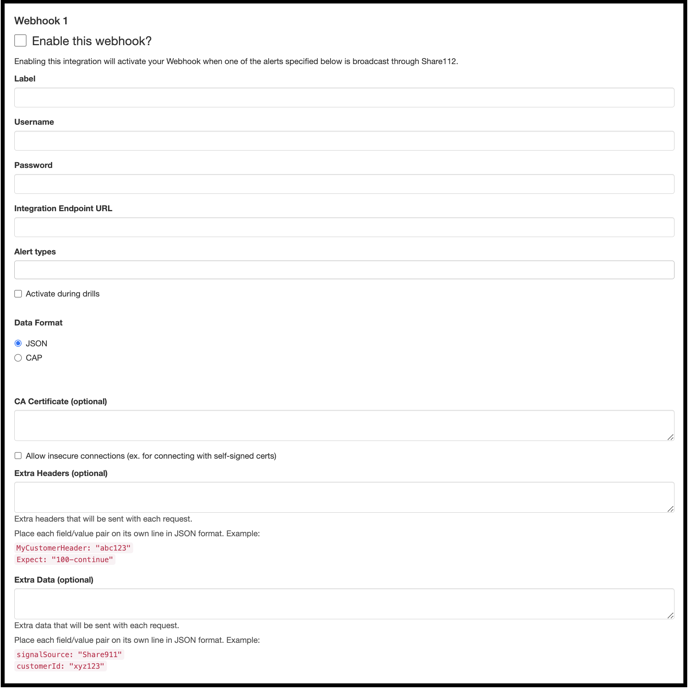Overview
Share911 can be configured to send data to a designated URL whenever certain events occur.
For help configuring Webhooks for your organization please contact support@share911.com.
Table of Contents
JSON
CAP
Configuring a Webhook
Share911 supports the use of up to 3 webhooks per channel.
Enable this webhook
Each webhook may be configured prior to it being enabled. This allows for staff to double-check values before going live.
Label
The name you would like to give this webhook. Used to keep track of how the webhook is used.
Username
The username to use when authenticating via Basic authentication.
Password
The password to use when authenticating via Basic authentication.
Integration Endpoint URL
The destination URL that will receive the webhook POST requests. This URL should support encryption (https) since Basic authentication is being used.
Alert Types
The alerts that this webhook should trigger on. For example, if only Lockdown and All Clear are selected then broadcasting an Evacuate alert would _not_ cause the webhook to activate.
Activate during drills
Controls whether this webhook should activate during drills.
Data Format
Determines the format of the data sent to the Endpoint URL: JSON, CAP
CA Certificate
An optional certificate to include when making the POST request.
Allow insecure connections
Controls whether the webhook request will permit connections using self-signed certificates.
Extra Headers
Optional headers that will be sent with the request. Place each field/value pair on its own line in JSON format.
Example:
MyCustomerHeader: "abc123"
Expect: "100-continue"
Extra Data
Optional extra data that will be sent with each request. Place each field/value pair on its own line in JSON format.
Example:
signalSource: "Share911"
customerId: "xyz123"
Webhook Payload
JSON
A JSON payload will be delivered directly as the body of the POST request using the "application/json" content type
Examples
LOCKDOWN - JSON
{
"eventType": "alert",
"eventId": "c95482d8-2adc-4434-b8dc-c5c5f049fa91",
"transId": "038b1cbc-996b-4442-b26d-7ced6d12cbeb",
"channelId": "bedford.k12.va.us/middle",
"channelName": "Bedford Middle School",
"eventName": "Lockdown",
"eventCode": 1,
"msg": "Test to demonstrate webhook integration",
"drill": true,
"addr": {
"street1": "1 Main St",
"street2": "",
"city": "Bedford",
"state": "VA",
"lat": 37.3258781,
"lng": -79.5034316,
"county": "Bedford County",
"zip": "24503"
},
"by": {
"userId": "sdflksfdjlj",
"firstname": "Adrian",
"lastname": "Lanning",
"title": "Share911 CTO",
"email": "adrian@share911.com",
"mobile": "+15555555555"
},
"timestamp": "2023-03-07T20:22:38.000Z",
"voiceText": "",
"myCustomData": "xyz123"
}
ALL CLEAR - JSON
{
"eventType": "alert",
"eventId": "3e79a6a8-7766-4978-adb6-34c922c1814c",
"transId": "7f64c089-f1ea-4cab-bfc3-22a5c941813a",
"channelId": "bedford.k12.va.us/middle",
"channelName": "Bedford Middle School",
"eventName": "All Clear",
"eventCode": 5,
"msg": "The event is over",
"drill": false,
"addr": {
"street1": "1 Main St",
"street2": "",
"city": "Bedford",
"state": "VA",
"lat": 37.3258781,
"lng": -79.5034316,
"county": "Bedford County",
"zip": "24503"
},
"by": {
"userId": "sdflksfdjlj",
"firstname": "Adrian",
"lastname": "Lanning",
"title": "Share911 CTO",
"email": "adrian@share911.com",
"mobile": "+15555555555"
},
"timestamp": "2023-03-07T20:27:57.000Z",
"voiceText": "",
"myCustomData": "xyz123"
}
Data Fields - JSON
eventType
The type of event: 'alert'
eventId
A UUID generated by Share911 for every event; can be safely ignored but may be useful when tracing a specific event's flow through the system.
transId
A UUID generated by Share911 for every alert; can be safely ignored but may be useful when tracing a specific alert's flow through the system.
channelId
Channel ID is the unique identifier of the communication channel on which the alert was broadcast. Typically each customer building will have its own channel in Share911. The easiest way to find the Channel ID is on the Manage Channel => Channel Info page, under either Channel ID or Share ID. You can also find the Channel ID by looking in the URL. For example, if the East Branch demo channel is opened in Share911, the Channel ID is the "sharevilledemo/eastbranch" part of the URL:
https://share911.com/sharevilledemo/eastbranch
channelName
Customer-defined name for the communication channel on which the alert was broadcast.
eventName
The name of the alert in English. For example, "Lockdown".
eventCode
A numeric ID which corresponds 1-to-1 with the "eventName". Can be used to avoid string comparison when identification of a specific alert type is required. Contact support@share911.com for a complete mapping of alert types to names.
msg
The optional message supplied when the broadcast was initiated.
drill
A boolean value indicating whether the event was during a drill or not.
addr
A JSON object representing the address of the target channel.
Has the following fields: street1, street2, city, state, lat, lng, county, zip
by
A JSON object representing information about the initiating user.
Has the following fields: userId, firstname, lastname, title, email, mobile
timestamp
The time the broadcast was initiated in ISO 8601 format.
CAP
An XML payload will be delivered directly as the body of the POST request using the "text/xml" content type.
Examples
LOCKDOWN - CAP
<?xml version = "1.0" encoding = "UTF-8"?>
<alert xmlns = "urn:oasis:names:tc:emergency:cap:1.2">
<identifier>c95482d8-2adc-4434-b8dc-c5c5f049fa91</identifier>
<sender>Share911</sender>
<sent>2023-03-07T20:22:38.000-00:00</sent>
<status>Exercise</status>
<msgType>Alert</msgType>
<scope>Private</scope>
<info>
<category>Security</category>
<event>Share911 Alert</event>
<responseType>Lockdown</responseType>
<urgency>Immediate</urgency>
<severity>Severe</severity>
<certainty>Observed</certainty>
<eventCode>
<valueName>Lockdown</valueName>
<value>1</value>
</eventCode>
<expires>2023-03-07T20:23:38.000-00:00</expires>
<senderName>Adrian Lanning</senderName>
<headline>Lockdown DRILL</headline>
<description>Test to demonstrate webhook integration</description>
<instruction></instruction>
<contact>adrian@share911.com</contact>
</info>
</alert>
ALL CLEAR - CAP
<?xml version = "1.0" encoding = "UTF-8"?>
<alert xmlns = "urn:oasis:names:tc:emergency:cap:1.2">
<identifier>3e79a6a8-7766-4978-adb6-34c922c1814c</identifier>
<sender>Share911</sender>
<sent>2023-03-07T20:27:57.000-00:00</sent>
<status>Actual</status>
<msgType>Alert</msgType>
<scope>Private</scope>
<info>
<category>Security</category>
<event>Share911 Alert</event>
<responseType>Lockdown</responseType>
<urgency>Immediate</urgency>
<severity>Severe</severity>
<certainty>Observed</certainty>
<eventCode>
<valueName>All Clear</valueName>
<value>5</value>
</eventCode>
<expires>2023-03-07T20:32:57.000-00:00</expires>
<senderName>Adrian Lanning</senderName>
<headline>All Clear</headline>
<description>The event is over</description>
<instruction></instruction>
<contact>adrian@share911.com</contact>
</info>
</alert>
Data Fields - CAP
identifier
A UUID generated by Share911 for every event; can be safely ignored but may be useful when tracing a specific event's flow through the system.
sender
The service responsible for the CAP message. Always "Share911"
sent
The time the broadcast was initiated in ISO 8601 format.![]()
status
Indicates whether the event was a drill or not. "Exercise" if drill, "Actual" otherwise.
msgType
The type of event. Always 'Alert'
scope
Indicates whether the information is Public, Restricted, or Private. Always "Private"
info.category
Always "Security"
info.event
Always "Share911 Alert"
info.responseType
The name of the alert in English
info.urgency
Always "Immediate"
info.severity
Always "Severe"
info.certainty
Always "Observed"
info.eventCode.valueName
Same as "info.responseType"
info.eventCode.value
A numeric ID which corresponds 1-to-1 with the "eventName". Can be used to avoid string comparison when identification of a specific alert type is required. Contact support@share911.com for a complete mapping of alert types to names.
info.expires
The time the broadcast should be automatically cleared
info.senderName
The sender's first and last name
info.headline
The name of the alert in English. For example, "Lockdown" or "Lockdown DRILL".
info.description
The message that the sender included in the broadcast
info.instruction
Always empty
info.contact
The sender's email address

